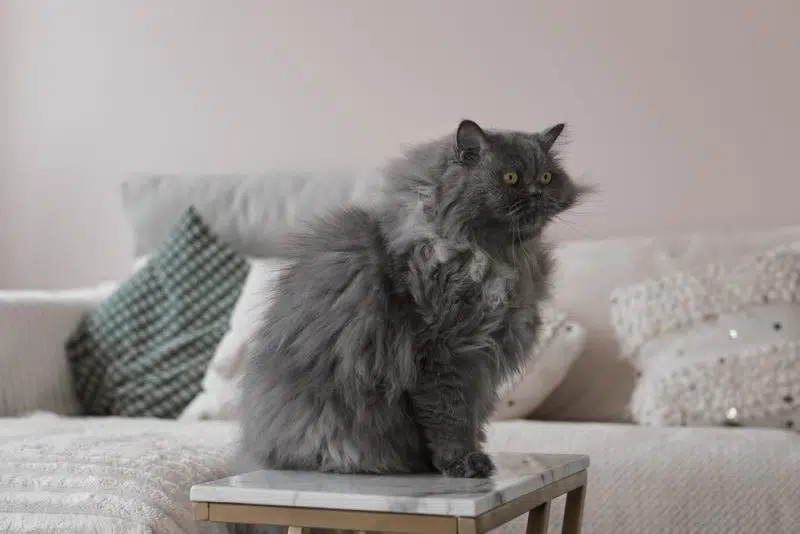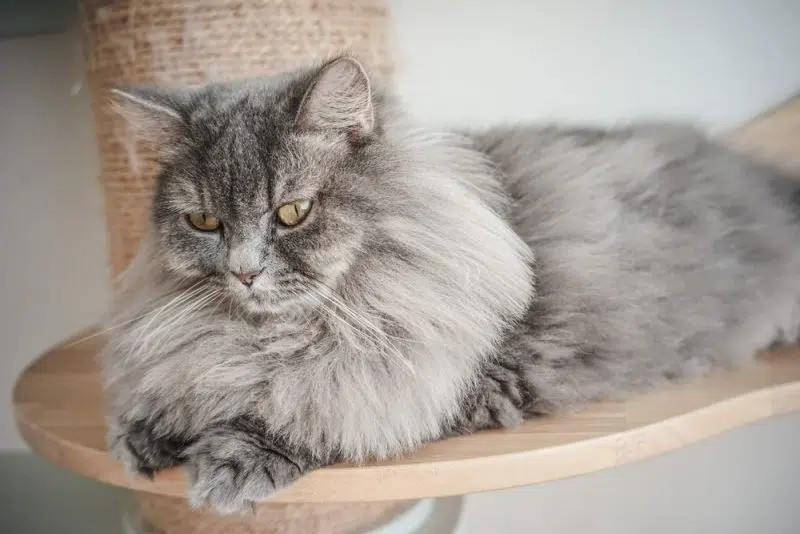Breed Overview Characteristics History Popularity Formal Recognition Fun Facts Are They the Right Pet for You?
The Grey Persian cat, often referred to officially as the Blue Persian, is a captivating color variation within the beloved Persian breed. Their coat color spans a beautiful spectrum, from the softest, almost ethereal pale grey to a more profound, striking slate grey. While white and black Persians might be more commonly encountered, the grey Persian is still readily available, making it an accessible choice for those enchanted by this hue. Importantly, their recognized status by cat fancier associations means Grey Persians can proudly participate in a wide array of cat shows and competitions.
Beyond their show-ring appeal, the Grey Persian cat excels as a cherished family companion. Known for their gentle nature, they thrive in tranquil environments. However, prospective owners should be aware of their sensitive disposition; Grey Persians can be reserved around unfamiliar faces and are easily startled by sudden loud noises or disruptions.
Breed Overview
Height: 10–15 inches
Weight: 7–12 pounds
Lifespan: 15–20 years
Colors: Grey (Blue)
Ideal Owner: Those seeking a devoted companion in a peaceful home setting
Temperament: Affectionate, loving, gentle, sensitive
The Persian cat, globally celebrated for its luxurious, flowing coat and distinctive, endearing flattened face, ranks among the most popular cat breeds worldwide. They are highly sought-after as companion animals and continue to be a favorite in the competitive world of cat exhibitions.
Grey Persians are medium-sized felines distinguished by their varied grey coats, ranging from delicate light shades to deeper, more intense greys. As pets, Grey Persian cats embody sweetness and affection, forming deep bonds with their families. However, their sensitive nature means they are best suited to quieter households and may not be ideal companions for boisterous young children or homes with overly energetic pets, particularly dogs with a strong play drive.
Grey Persian Cat Breed Characteristics
Understanding the typical characteristics of the Grey Persian cat breed can help you determine if they are a good fit for your lifestyle. Here’s a closer look at key traits:
Energy Level:
- A cat’s energy level is crucial. High-energy cats need significant daily engagement through play and mental challenges to maintain their well-being. Lower-energy breeds, like the Grey Persian, require less intense physical activity but still benefit from mental stimulation to prevent boredom. Matching a cat’s energy needs to your lifestyle is essential for a harmonious relationship.
Trainability:
- Trainability varies across cat breeds. Easily trainable cats quickly grasp commands and adapt to routines with minimal effort. More independent or stubborn breeds may require greater patience and consistent training techniques. While Persians are not known for being highly trainable like some breeds, they can learn basic commands, especially with positive reinforcement.
Health:
- Breed-specific health predispositions are important to consider. Some breeds are more susceptible to certain genetic health issues than others. This doesn’t guarantee a cat will develop these problems, but it indicates an increased risk. Being informed about potential health concerns allows owners to prepare for possible needs and ensure proactive care. Persians, for example, can be prone to polycystic kidney disease and breathing difficulties due to their facial structure.
Lifespan:
- A cat’s lifespan can be influenced by breed, size, and genetic factors. Proper care, including balanced nutrition, regular exercise, mental enrichment, and good hygiene, significantly contributes to a cat’s longevity and overall quality of life. Grey Persians, with good care, often enjoy a long lifespan.
Sociability:
- Sociability describes how cats interact with humans and other animals. Highly social cats readily seek interaction, enjoying cuddles and attention from both familiar people and even strangers. Less social cats may be more reserved, cautious, or even prone to hiding. Early socialization is vital for all cats, regardless of breed, to help them become well-adjusted companions. While Grey Persians are affectionate with their families, they can be initially shy with strangers.
 grey-persian-cat-sitting-in-a-living-room
grey-persian-cat-sitting-in-a-living-room
Tracing the Elegant History of Grey Persians
The precise origins of the Persian cat remain somewhat shrouded in historical debate. Written records dating back to the 17th century meticulously describe cats resembling the Persian breed we recognize today. Popular theories suggest these elegant felines journeyed to Europe via various routes – carried by noble travelers, seafaring sailors, enterprising merchants, or adventurous explorers. Regardless of the exact path, it’s undeniable that they rapidly gained favor within European society. Intriguingly, genetic analysis reveals a close genetic kinship between Persians and other cat breeds originating in Western Europe, adding another layer to the breed’s complex history.
An alternative, more romantic theory proposes an ancient lineage, pointing to hieroglyphic depictions of cats bearing a striking resemblance to the modern Persian. This suggests the ancestors of these fluffy felines might have graced the earth thousands of years ago, weaving a long and captivating story through time.
Regardless of their ultimate origin, the Persian cat became immensely popular throughout Europe, establishing itself as a breed of distinction and beauty. Their allure crossed the Atlantic in the late 19th century, when the first Persian cats were introduced to America, where they were met with equal admiration and enthusiasm.
The Rise to Fame of Grey Persian Cats
The ascent of the Persian cat breed, including the enchanting Grey Persian, to widespread popularity is intertwined with the patronage of royalty and nobility. Queen Victoria of England, a known animal enthusiast, famously kept several Persians throughout her reign, lending them a regal aura. Florence Nightingale, the celebrated social reformer and statistician, also held a fondness for Persians, further enhancing their prestige.
Beyond royal circles, the breed’s striking appearance propelled them into the limelight of popular culture. The quintessential villain Blofeld in the James Bond film series famously owned a white Persian, while Mr. Bigglesworth, Dr. Evil’s beloved companion in the Austin Powers comedies, was also a Persian, albeit one who suffered a humorous mishap. Mr. Tinkles, the scheming antagonist in the family film Cats & Dogs (2001), further solidified the Persian’s presence in cinematic history.
Concurrently, the breed’s luxurious long coat and captivating facial features made them stars of cat shows and animal exhibitions. In a landmark moment, a Persian cat claimed the top prize at the very first official cat show, marking the beginning of their reign in the competitive cat fancy world.
Acknowledging the Grey Persian Breed
The immense popularity of the Persian cat, upon its arrival in the United States in the late 1800s, led to its swift recognition as a foundational breed by the Cat Fanciers’ Association (CFA) in 1906, just a few years later. Today, the Grey Persian, as a color variation, and the Persian breed as a whole are formally recognized by all major cat fancier associations globally. They remain one of the most frequently exhibited and highly esteemed breeds in the cat fancy.
The inaugural cat show, held in London in 1871, witnessed a Persian cat crowned as the supreme champion, solidifying its legendary status in the annals of domesticated cat history. The Grey Persian is a naturally occurring and standard color within the Persian breed, recognized as one of the most common and admired Persian cat color variations.
 grey-persian-cat-sitting-on-sofa
grey-persian-cat-sitting-on-sofa
Intriguing Facts About Grey Persian Cats
Grey Persian cats are more than just beautiful; they possess a range of unique and fascinating traits:
1. Consistent Show Winners
From the earliest cat shows to contemporary competitions, Persian cats consistently achieve victory. Their lavish coats and charming faces are undeniably captivating to judges and audiences alike. However, potential owners must be prepared for the commitment required to maintain this magnificent coat in pristine condition. Regular grooming is not just recommended; it’s essential.
2. A Breed with a Premium Price Tag
The Persian breed’s enduring popularity in both show rings and homes as beloved companions contributes to a higher purchase price. A Persian cat with a documented pedigree, especially from champion lines, can command a price in the thousands of dollars. Prospective owners should factor this cost into their decision.
3. Not Natural Athletes
Persians are classified as medium-sized cats, but they possess a sturdy, somewhat heavy build. This conformation means they are not renowned for their athletic prowess. While they can easily navigate furniture and hop onto laps for cuddles, they may struggle with higher jumps or more demanding physical activities. Their grace lies in their elegance, not agility.
4. Sensitive Souls
Grey Persians are known for their docile and deeply affectionate nature toward their chosen humans. However, they are also recognized for their sensitivity. Loud, sudden noises or overly chaotic environments can induce stress in these gentle cats. Introducing them to new pets or changes in their environment requires patience and a gradual, careful approach to minimize anxiety.
 grey-persian-cat-resting-indoor
grey-persian-cat-resting-indoor
Is a Grey Persian Cat the Perfect Pet For You?
The Grey Persian cat, a frequent sight at prestigious cat shows, also thrives as a wonderful companion animal for the right owner. Their inherent sensitivity suggests they might not be the most suitable match for households with very young children. The energetic play and unpredictable nature of small children can be overwhelming for this breed. Similarly, integrating a Grey Persian into a home with existing pets requires a slow and carefully managed introduction process. And, of course, their signature long coat necessitates consistent and dedicated grooming.
However, the rewards of owning a Grey Persian cat are immeasurable for those prepared to meet their specific needs. They are inherently sweet and gentle-natured cats, overflowing with love and affection for their cherished human families. While they appreciate and thrive on affection, they are not excessively demanding of attention, striking a lovely balance for many owners.
 divider cat faces oct 2024
divider cat faces oct 2024
Conclusion
The Grey Persian cat, officially and often known as the Blue Persian cat, presents a captivating grey-toned variant within the Persian breed. Characterized by their long, dense coats and distinctive, rounded, and somewhat flattened faces, they are instantly recognizable. This breed played a pivotal role as a founding member of the Cat Fanciers’ Association and has maintained its esteemed position as a popular entrant in cat shows and exhibitions throughout the years.
While Grey Persians make exceptional companions, their sensitive nature means they are best suited to specific home environments and owners who understand their needs. For those who can provide a calm and loving setting, the Grey Persian cat offers a lifetime of gentle companionship and unwavering affection.
Sources
Featured Image Credit: Abbasi7060, Shutterstock

